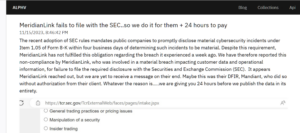10 Common Cyberattacks & How to Outsmart Them

Cyberattacks aren’t just a “big business” problem. They’re happening every day to freelancers working in cafés, to small businesses that skipped one security update, to local schools, hospitals, nonprofits, and yes… even to you, reading this on public Wi-Fi. That being said, you can outsmart them.
Just ask MGM Resorts whose 2023 ransomware attack shut down slot machines, locked guests out of rooms, and cost the company over $100 million, or Victoria’s Secret who recently disclosed a supply chain breach that leaked sensitive employee data and disrupted operations. These weren’t “tech companies.” But, they were unprepared.
So what went wrong? It’s often the same 10 attacks recycled, renamed, repackaged but still working like a charm because most people don’t know how to spot them.
But today? That ends with you. Whether you’re a business owner, tech student, or just security curious this guide breaks down the top cyberattacks everyone should understand and how to outstmart them
Let’s begin.

1. Phishing (Still #1 in the Game)
Phishing is the OG scam that never dies. Fake emails, texts, or calls designed to trick you into clicking shady links, downloading malware, or handing over sensitive info like passwords and bank details.
What Phishing Looks Like:
“Your account has been suspended. Click here to verify.”
“We noticed unusual activity on your login.”
“Congrats! You’ve won a $100 gift card, claim now.”
It’s not always obvious. Some phishing emails look exactly like they came from your bank, your boss, or your favorite app even with the logo and formatting to match.
How to Outsmart Phishing:
- Always verify the sender and don’t trust display names alone
- Enable multi-factor authentication (MFA) to add a security layer
- Train your team (or yourself!) to hover over links and look for weird domains
- Use email filters and anti-phishing tools (like Microsoft Defender or Proofpoint)
Pro Tip: If something seems urgent or scary, pause before clicking. Hackers use emotion to override logic.
2. Malware & Ransomware
Malware is short for malicious software: the code that sneaks into your system, spies on you, steals data, or gives hackers full control.
Ransomware is its evil cousin. It encrypts your files and locks you out until you pay up (usually in crypto).
What Malware Looks Like:
- That “invoice” attachment you didn’t expect
- A sketchy browser pop-up offering free antivirus
- A pirated app or software crack you downloaded
- A silent exploit hiding in outdated software
One wrong click and boom — your screen freezes with a message like:
“Your files have been encrypted. Pay $500 in Bitcoin to restore access.”
How to Outsmart Malware:
- Use antivirus + endpoint detection & response (EDR) to spot threats fast
- Backup your files regularly and store copies offline
- Keep all apps and systems patched and up-to-date
- Don’t download random files or plug in unknown USBs
Pro Tip: Even massive companies like Colonial Pipeline and hospitals have been taken down by ransomware. It’s not a matter of “if,” but when so defense needs to be layered and proactive.
3. Zero-Day Exploits
These are the ninja-level attacks that no one sees coming. A zero-day exploit takes advantage of a software vulnerability that the developers don’t even know exists yet. That means there’s zero time to patch it before hackers can strike.
What Zero-Day Exploits Look Like:
Massive breaches caused by “unknown bugs” in common apps or plugins. Think government agencies or Fortune 500s suddenly scrambling to update everything.
How to Outsmart Zero-Day Exploits:
- Always update software patching regularly narrows the attack window
- Use a vulnerability management tool that alerts you to newly discovered exploits
- Monitor threat intelligence feeds to stay ahead of the curve
- Limit app permissions so even if one app gets hit, the blast radius is small
Pro Tip: Just because it’s “up to date” doesn’t mean it’s bulletproof. Stay proactive.
4. SQL Injection
One of the OG web hacks. SQL injection (SQLi) lets attackers manipulate a website’s database by entering malicious code into form fields like login boxes or search bars.
What SQL Injection Looks Like:
A login box that lets you in without a password because the input tricks the database.
E.g., typing: ‘ OR 1=1– into a login field can bypass authentication.
SQL Injection is Used for:
- Stealing customer data
- Changing or deleting content
- Taking over accounts
How to Outsmart SQL Injection:
- Sanitize all user inputs (no raw data into your SQL queries)
- Use parameterized queries in your code
- Regularly run pentests to find and fix vulnerable inputs
- Deploy web application firewalls (WAFs) for added protection
Pro Tip: If your site takes user input, it’s a target.
5. Social Engineering Attacks
This is hacking humans, not machines. Social engineering attacks manipulate people into giving up info or access.
Social Engineering Tactics include:
- Pretending to be your boss asking for urgent help
- Fake IT support asking for passwords
- “Tailgating” into secure buildings (yes, physical security matters too!)
How to Outsmart Social Engineering:
- Conduct regular employee training on red flags
- Use internal communication codes or protocols
- Encourage a “trust but verify” workplace culture
- Report suspicious behavior without shame
Pro Tip: The weakest link in any security system is usually the human.
6. Password Attacks
Passwords are still one of the biggest points of failure especially when people reuse them.
Types of Password Attacks:
- Brute force: guessing passwords until one works
- Credential stuffing: using leaked passwords from other sites
How to Outsmart Password Attacks:
- Enforce long, complex password policies
- Use multi-factor authentication (MFA) everywhere
- Encourage (or require) password managers
- Monitor for credential breaches on the dark web
Pro Tip: “Summer2025!” isn’t a secure password.
7. Man-in-the-Middle (MitM) Attacks
Imagine you’re talking to your bank, but someone’s listening in or even altering what’s being said without you knowing. That’s a man-in-the-middle attack.
Where MitM Attacks Happen:
- On public Wi-Fi
- On websites without HTTPS
- Through compromised routers or APIs
How to Outsmart MitM Attacks:
- Use VPNs on public or shared networks
- Only visit sites with HTTPS (look for the 🔒 in the url)
- Monitor for certificate issues or DNS changes
Pro Tip: Never log into sensitive accounts on airport or coffee shop Wi-Fi without a VPN.
8. DNS Spoofing / Poisoning
You type in your bank’s URL, hit enter and boom, you land on a hacker’s fake site that looks just like the real one. Welcome to DNS spoofing.
What DNS Spoofing Looks Like:
Legit URL, fake destination. Designed to steal your login info or drop malware.
How to Outsmart DNS Spoofing:
- Use secure DNS settings (like Quad9 or Cloudflare)
- Deploy DNSSEC to authenticate DNS responses
- Educate your team on how to spot spoofed pages
Pro Tip: Check the URL carefully — one wrong letter can mean big trouble.
9. DDoS Attacks (Distributed Denial of Service)
Hackers flood your website or server with so much traffic that it crashes. No one can log in, shop, or even visit your site.
Who DDoS Attacks target:
E-commerce sites, banks, schools basically anyone who relies on uptime.
How to Outsmart DDoS Attacks:
- Use a CDN (Content Delivery Network) with built-in DDoS protection
- Deploy firewalls and rate-limiting tools
- Have an incident response plan to mitigate damage quickly
Pro Tip: DDoS isn’t just downtime. It’s lost revenue, reputation damage, and customer trust.
10. Insider Threats
Sometimes, the call is coming from inside the house. Insider threats are employees, contractors, or ex-staff who intentionally (or accidentally) expose your company to risk.
Why Insider Threats happen:
- Revenge
- Negligence
- Lack of off-boarding procedures
How to Outsmart Insider Threats:
- Enforce least privilege access (only what they need)
- Monitor user behavior and access logs
- Have strong off-boarding and access removal policies
- Segment networks to limit damage
Pro Tip: Trust your team but log everything.
Bonus: How to Protect Yourself (or Your Business)
Implement Cybersecurity Awareness Training
Human error is the biggest entry point for hackers. Train your team (or yourself) to recognize phishing, social engineering, and suspicious behavior.
Pro Tip: Make it fun with simulations and rewards!
Use MFA Everywhere
Even if a password gets stolen, MFA adds a lock that hackers can’t pick easily. It’s your second (and stronger) line of defense.
Schedule Regular Pentests
Penetration testing helps uncover the gaps in your systems before an attacker finds them. It’s like hiring an ethical hacker to show you how secure (or vulnerable) you really are.
Keep Software Updated
Those annoying “update now” pop-ups? They patch security holes hackers actively exploit. Stay current or stay exposed.
Never Trust Always Verify
Whether it’s an email, a login, or a third-party vendor, apply the Zero Trust mindset: Assume nothing, verify everything.
Closing Thought:
Cybersecurity is no longer optional. It’s daily hygiene for your digital life.
The more you know, the harder you are to hack.





